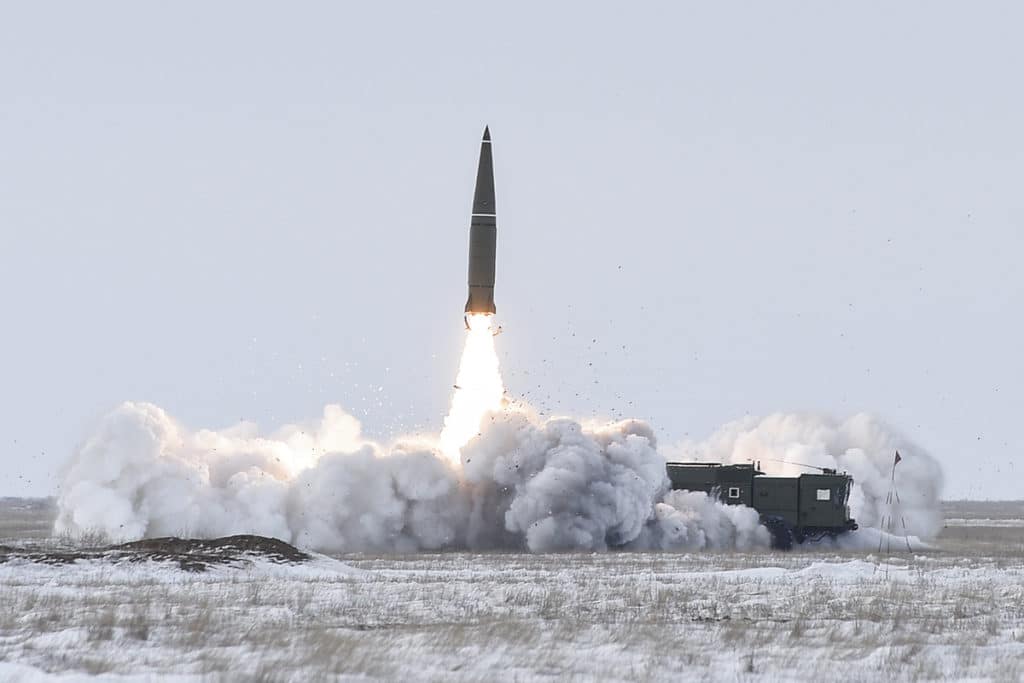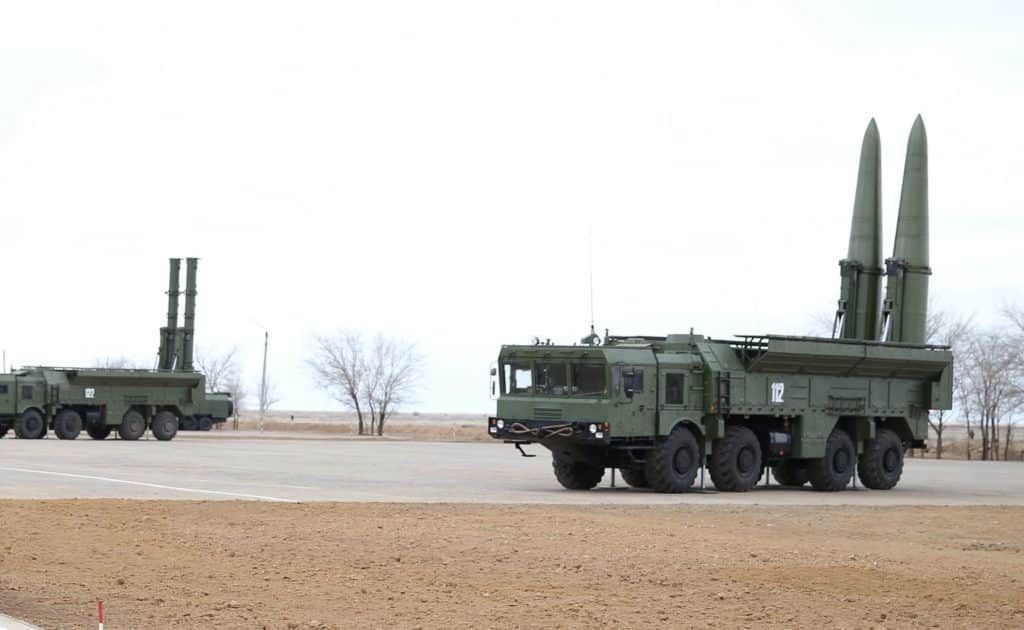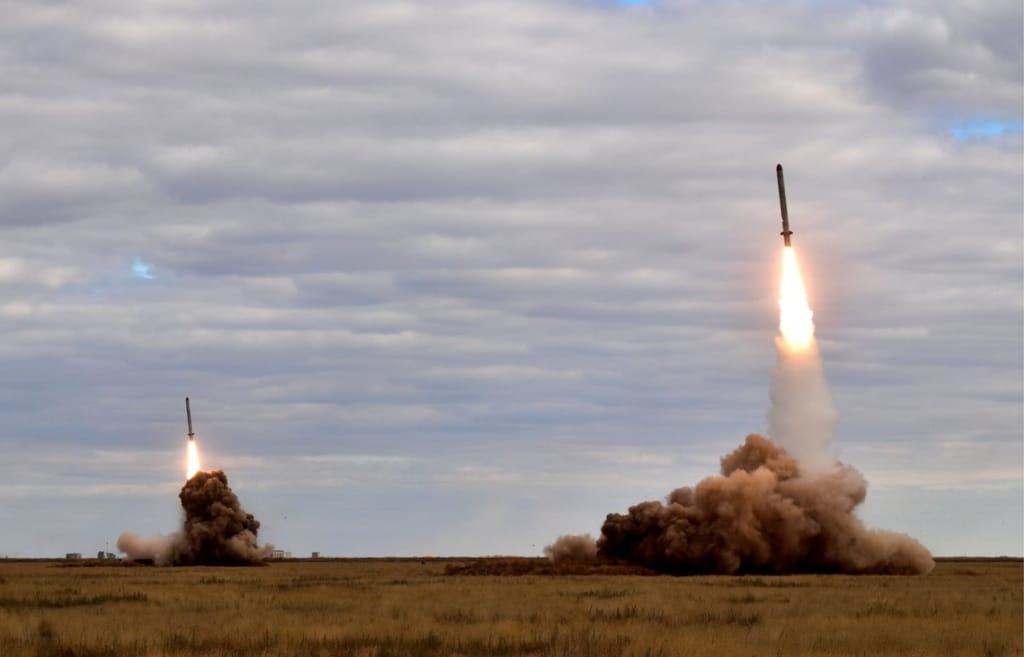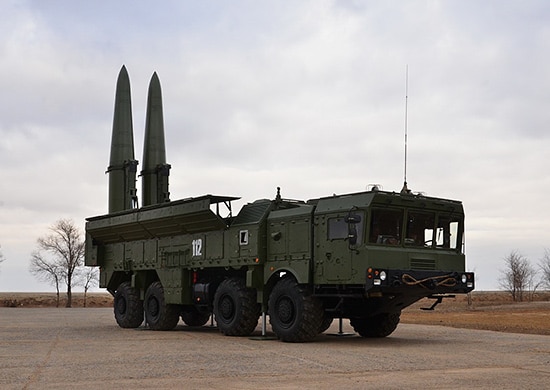The 9K720 Iskander (NATO: SS-26 “Stone”) is a road-mobile short-range ballistic missile (SRBM) with a range of up to 500 km. Using a common transporter-erector-launcher (TEL) and support vehicles, the system can also fire the 9M728 (R-500, SSC-7) and 9M729 (SSC-8) cruise missiles.
Iskander (SS-26 “Stone”) at a Glance
- Originated from
- Russia
- Possessed by
- Russia, Algeria, Armenia
- Alternate names
- Stone, Tender, 9M720, 9M723, 9M723-1
- Class
- Short-Range Ballistic Missile (SRBM)
- Basing
- Road-mobile
- Length
- 7.3 m
- Diameter
- 0.92 m
- Launch weight
- 3,800-4,020 kg
- Payload
- 480–700 kg, 480 kg (export variant)
- Warhead
- High-explosive, submunition, earth-penetrator, thermobaric
- Propulsion
- Single-stage solid propellant
- Range
- 400–500 km, 280 km (Export variant)
- Status
- Operational
- In service
- 2006



Iskander Development
Russia began development of the SS-26 in the late 1980s to replace the OTR-23 “Oka” SRBM. After the Intermediate Nuclear Forces (INF) Treaty banned the OTR-23 in 1987, the Soviet Machine Industry Design Bureau in Kolomna (KBM) modified the the Oka’s solid rocket motor for a new missile design.1 KBM began developing the Iskander complex in 1993.2 In 1998, Russia began state trials of the missile, completing 13 flights at Kasputin Yar test range until 2005.3 The Iskander system finally entered Russian service in 2006. In 2010, Russia tested an updated missile—the 9M723-1—and accepted it into service in 2012.4
Variants
Replacing both the OTR-23 “Oka” and OTR-21 “Tochka-U” SRBMs, the Iskander is a tactical missile system capable of launching ballistic and cruise missiles.5 The “Iskander” designation is typically used to identify both the launch system and its associated ballistic missiles, the Iskander-M (9M723), exclusive for Russian military use, and the Iskander-E (9M720) for export. A third variant uses the Iskander-M transporter-erector-launcher (TEL) to fire the SSC-7 (9M728) cruise missile.
The 9M723 and 9M720 Ballistic Missiles
The 9M723 SRBM is 7.3 meters long, 0.92 meters in diameter, and has a launch weight of 3,750 kilograms.6 The missiles possesses a maximum range of 500 km and carries payloads between 480 and 700 kg. The export variant, the 9M720, has a reduced range of 280 km while carrying a 480 kg payload.7
These missiles fly on a depressed trajectory and can maneuver up to 30g in flight. The 9M720 is reportedly accurate to 200 meters circular error probable (CEP) with inertial guidance (at 300km range), 50 meters with GLONASS satellite guidance, and 10 to 20 with with an optional optical seeker.8 The optional optical seeker-equipped warheads, which detach in flight, use a digital scene matching area correlation (DSMAC) terminal guidance system to detect targets. 9 The seeker was flight tested in 2011 and entered service in 2012.10
The 9P78 Launcher and Support Vehicles
and Support Vehicles
The Iskander launcher is based on an eight-wheel MZKT 7930 truck, weighing 43 tonnes when loaded with two 9M720/9M723 missiles.11
The Iskander TEL is equipped with an armored roof to protect its two ballistic or cruise missiles. The TEL’s cabin is hardened against chemical, biological, radiological, and nuclear (CBRN) hazards and extreme temperatures, with an operating range between -50 to 50 degrees Celsius. The vehicle is also amphibious and can travel at speeds up to 70 km/h (43 mph) for 1,100 km (684 miles). Each TEL is capable of operating independently. Reload vehicles, each carrying two missiles and a crane, enable prolonged battlefield operations.12 A command vehicle, based on a KAMAZ-43101 truck, can communicate with multiple Iskander units and send new target coordinates to launch crews.13
Cruise Missile Developments and INF Treaty Violation
Through the 2000s, Russia has fitted Iskander TELs with ground-launched cruise missiles. Carrying two SSC-7 (9M728) cruise missiles—reportedly a variant of the 3M54 ‘Klub’—the system was informally referred to as the ‘Iskander-K’ combat system. Russia first flight tested this variant in 2007, which reportedly entered service in 2013.14 In 2019, the Kremlin displayed a new launcher carrying four SSC-8 (9M729) cruise missiles. According to U.S. government reports, the Russian military first tested the Iskander/SSC-8 system in 2014, violating the INF Treaty, which prohibited ground-launched cruise missiles with ranges over 500 km.15 In a 2019 statement, the United States cited Russian development of the SSC-8 as a major factor in its decision to withdraw from the INF Treaty.16
Exports and Foreign Operators
Russia first exhibited the Iskander-E for sale in 1999. By 2005, it was reported that the United Arab Emirates, Syria and Iran had discussed potential purchases, a claim Russian officials later denied.17 In 2008, Russian defense figures stated that Kuwait, South Korea, Syria, the UAE, Malaysia, and India had shown interest in purchasing the Iskander-E.18 Despite supply shortages reported in 2014, Russia allegedly negotiated with Saudi Arabia on an Iskander-E sale in 2015, which other officials later denied.19
In 2016, Armenia became the first buyer of the Iskander-E and paraded them later that year.20 Algeria then bought 4 Iskander-E regiments—totaling 48 TELs and 120 support vehicles—in 2017.21
Iskander Service History
Russia operates 11 combat brigades of Iskander-M systems as of 2019.22 A standard Iskander brigade includes 12 TELs and their associated support vehicles. In April 2019, the Kolomna Machine-Building Design Bureau began constructing the final brigade set of Iskander-M systems, which it delivered to Russia’s 448th Missile Brigade in November 2019.23 According to Russian media reports, the Kremlin plans to enlarge its Iskander brigades from 12 to 16 launchers each.24
The Russian armed forces first used the the system in combat against Georgia in 2008. The Kremlin also deployed a unit to Syria in 2016 but did not use the missiles in combat.25 Tajikistan and Russia first launched an Iskander-M missile outside of Russian soil during a military exercise in June 2017.26
Russia has routinely deployed the Iskander-M to Kaliningrad, where the weapon could target NATO forces in Poland, the Baltic States, and Sweden. These deployments are a crucial element of Russian coercive diplomacy. From 2009, Russia repeatedly threatened to deploy Iskander-M missiles in response to U.S. missile defense deployments in the region, sending units to Kaliningrad in 2013, 2015, and 2016.27 Russia has permanently deployed the Iskander-M in Kaliningrad since 2018.28
Footnotes
- “INF Treaty: At a Glance,” Fact Sheet, U.S. Department of State, December 8, 2017, https://www.state.gov/inf-treaty-at-a-glance/; James O’Halloran, IHS Jane’s Weapons: Strategic 2015 – 2016, (London: IHS, 2015).
- Missile system ‘Iskander’,” Sputnik News, May 4, 2018, https://ee.sputniknews.ru/infographics/20180405/10020713/iskander.html
- Ibid.
- Roman Azanov et al., “Russia’s Daunting Iskander-M Missile System: Secure as a Stonewall Shield,” TASS, 2017, http://iskander.tass.com/.
- “Russia’s Iskander-M tactical missiles to carry various types of warheads,” TASS, February 5, 2019, https://tass.com/defense/1043348
- Russia’s Arms and Technologies 2001, 71; O’Halloran, IHS Jane’s Weapons, pp. 80–82.
- Ibid.
- Russia’s Arms and Technologies: The XXI Century Encyclopedia, Volume II, Rocket and Artillery Armament of Ground Forces (Moscow, 2001, Publishing House ‘Arms and Technologies’)
- Ibid.
- Ibid; “Iskander taught to blow up the subway from a photo,” Izvestia, November 13, 2011, https://iz.ru/news/506652; U.S. Defense Intelligence Agency, Russia Military Power: Building A Military to Support Great Power Aspirations, (Washington: Defense Intelligence Agency, 2017), https://www.dia.mil/portals/27/documents/news/military%20power%20publications/russia%20military%20power%20report%202017.pdf; Stefan Forss, “The Russian Operational-Tactical Iskander Missile System,” Working paper Series 4, No. 42, (Helsinki: National Defence University, 2012), https://www.doria.fi/bitstream/handle/10024/84362/StratL4_42w.pdf.
- Russia’s Arms and Technologies 2001, 71.
- Ibid.
- Russia’s Arms and Technologies 2001, 73.
- Azanov 2017.
- Congressional Research Service, Russian Compliance with the Intermediate Range Nuclear Forces (INF) Treaty: Background and Issues for Congress, Report No. R43832, (Washington: Government Publishing Office, February 2019), https://crsreports.congress.gov/product/pdf/R/R43832/33; Daniel Coats, “On Russia’s INF Treaty Violation,” Press briefing, Washington, November 30, 2018, https://www.dni.gov/index.php/newsroom/speeches-interviews/item/1923-director-of-national-intelligence-daniel-coats-on-russia-s-inf-treaty-violation; “Foreign military attaches, media get a look at 9M729 launchers,” TASS, January 23, 2019, https://tass.com/defense/1041360; “Russian MoD Shows Iskander-M Launchers with 9M729 Rockets Amid INF Row With US,” Sputnik, January 29, 2019, https://sputniknews.com/military/201901231071735501-inf-treaty-rocket-9m729-russia-defence-ministry/.
- Michael R. Pompeo, “U.S. Intent To Withdraw from the INF Treaty,” Press statement, Washington, February 2, 2019, https://www.state.gov/u-s-intent-to-withdraw-from-the-inf-treaty-february-2-2019/.
- O’Halloran, IHS Jane’s Weapons, pp. 80 – 82; “Russia did not supply Iskander systems to Syria – Isaikin,” TASS, February 13, 2013, https://tass.com/archive/689639; “Russia is not in talks with Saudi Arabia over Iskander supplies – Rostec corporation head,” TASS, November 9, 2015, https://tass.com/defense/834792.
- Martin Sieff, “Russia’s Iskander is ideal weapon to hit BMD bases,” UPI, October 3, 2008, https://www.upi.com/Defense-News/2008/10/03/Russias-Iskander-is-ideal-weapon-to-hit-BMD-bases/21841223055335/.
- “No Iskander missile system export until 2016 – design bureau,” TASS, August 13, 2014, https://tass.com/russia/744772; “Why Russia Restricts Sale of Iskander Missile Systems to Its Closest Partners,” Sputnik, September 3, 2017, https://sputniknews.com/military/201709031057046466-iskander-exports-prospects-analysis/.
- U.S. Congress, Commission on Security and Cooperation in Europe, The Growing Russian Military Threat in Europe, 115th Cong., 1st Sess., May 17, 2017, https://www.csce.gov/sites/helsinkicommission.house.gov/files/GrowingRussianThreat.pdf; Armen Grigoryan, “After a Delay, Russia Delivers New Types of Weapons to Armenia” Eurasia Daily Monitor, Vol. 13, Iss. 154, (September 26, 2016), https://jamestown.org/program/after-a-delay-russia-delivers-new-types-of-weapons-to-armenia/#.V-p0hfl96Uk; “PM: Armenia has sufficient amount of Iskander-E missiles,” News.am, June 7, 2019, https://news.am/eng/news/517164.html.
- Andrew McGregor, “Defense or Domination? Building Algerian Power With Russian Arms,” Eurasia Daily Monitor, Vol. 15, Iss. 122, (September 5, 2018), https://jamestown.org/program/defense-or-domination-building-algerian-power-with-russian-arms/.
- Azanov, 2017; Ministry of Defence of the Russian Federation, “Land forces receive 10 brigade sets of Iskander-M missile systems,” News release, December 29, 2017, http://eng.mil.ru/en/news_page/country/more.htm?id=12156722@egNews; “Russia begins production of 11th brigade set of tactical missile system Iskander,” TASS, April 12, 2019, https://tass.com/defense/1053445.
- “Russian army completes rearmament to Iskander missile system,” TASS, November 21, 2019, https://tass.ru/armiya-i-opk/7176637; Alexander Khrolenko, “NATO, hi: Iskander-M received all missile brigades of the Russian Federation, Sputnik News, November 22, 2019, https://ee.sputniknews.ru/columnists/20191122/18533898/Effekt-ot-davleniya-na-RF-na-Iskander-M-pereshli-vse-raketnye-brigady.html; “Russian army to be reequipped with Iskander-M missile systems in 2019 – Defense Ministry,” TASS, January 1, 2019, https://tass.com/defense/1038781.
- Alexey Ramm and Bogdan Stepova, “Missile Association: the Iskander-M brigades increased firepower,” Izvestia, December 16, 2019, https://iz.ru/952462/aleksei-ramm-bogdan-stepovoi/raketnoe-obedinenie-brigadam-iskanderov-uvelichili-ognevuiu-moshch.
- Frank A. Rose, “Speech to the U.S.-UAE Business Council,” (Speech, Abu Dhabi, October 12, 2016), https://2009-2017.state.gov/t/avc/rls/263148.htm.
- “WATCH First Launch of Iskander-M Missiles Outside of Russia (VIDEO), Sputnik, June 3, 2017, https://sputniknews.com/military/201706031054276545-iskander-launch-outside-russia/.
- Andrew Roth, “Deployment of Missiles Is Confirmed by Russia,” The New York Times, December 16, 2013, https://www.nytimes.com/2013/12/17/world/europe/russia-deploys-missiles-in-western-region.html; Marie Harf, “Daily Press Briefing – December 16, 2013,” Press briefing, Washington, December 16, 2013, https://2009-2017.state.gov/r/pa/prs/dpb/2013/12/218802.htm; “Russia deploys nuclear-capable missiles in Kaliningrad,” BBC News, October 9, 2016, https://www.bbc.com/news/world-europe-37597075; “Russia will target US missile defense sites if no deal – Medvedev,” Russia Today, November 23, 2011, https://www.rt.com/russia/medvedev-comments-missile-defense-031/.
- “Russia Deploys Iskander Missiles to Kaliningrad,” Missile Threat, February 5, 2018, https://missilethreat.csis.org/russia-deploys-iskander-missiles-kaliningrad-2/.